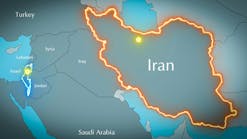Building the cleanest refinery on the planet
WILLIAM PRENTICE, MERIDIAN ENERGY GROUP INC., BELFIELD, ND AND IRVINE, CA
TOM SKWAREK, MERIDIAN ENERGY GROUP INC., LONDON
The industrial revolution would not have been possible without innovations that included new ways of organizing people and capital, and managing the balance of risks and returns associated with building and operating major productive assets. The domestic refining industry has a colorful history rooted in the industrial revolution, and currently represents billions of dollars in investment, employs thousands of people, and produces some 9 million barrels per day of refined products for US and international markets.
The current asset base of the US domestic refining industry is decades old. Although several crude topping units have been built in recent years, the most recent grassroots complex refinery was completed in 1976 in Garyville, Louisiana. Due to an uneasy truce with local, state, and federal regulatory agencies, the industry has had to cope with regulatory demands, technological advances, and a changing and growing market through frequent modifications and additions to existing capacity.
ENERGIZE THE LOCAL MARKET
About six years ago, a group of people residing on the West Coast, all of them descendants of a family with roots in agricultural North Dakota, formed the Davis Family Partnership and dispatched its managing partners to North Dakota to repurchase the original family agricultural lands. While in the area, those representatives, led by the Meridian founder, saw what was happening in the Bakken, and the opportunity to ensure that long-term, sustainable, and skilled employment was made available to North Dakota's families. The Davis Refinery and the specialist skills to build and operate it would achieve this goal by guaranteeing 200 skilled refinery jobs and up to 2,400 local jobs in providing services to the refinery and the growing local community.
NAVIGATING AS A START-UP
From the beginning, our project has had to cope with all the usual development and financing challenges, yet it also had to deal with the fact that its owner and operator, Meridian Energy Group Inc., is a start-up company. To get the project moving, it was first necessary to build the team and resolve the initial capitalization of the firm.
Meridian has been very fortunate to identify and secure the services of some of the top people in the business, both at the operational level and for overall governance. In addition, Meridian has found that the local North Dakota labor pool is an exceptional resource, and therefore we have the human resources needed at both the leadership and the operational level.
As a start-up company, the initial capitalization of Meridian was a bigger challenge than first anticipated. Formed in the shadow of "Peak Oil" predictions and the fascination with wind and solar solutions, Meridian found that there were very few early-stage institutional capital providers looking to invest in a firm that wanted to build a crude oil refinery. Instead we followed the successful capital-raising strategy used by many independent exploration and production firms and formed our own in-house group to pursue a company-direct private placement of stock.
Our private investors brought Meridian to its current stage of progress, including engineering definition, permitting, and formation of strategic project agreements. Private investors, through the in-house offering, are funding the initial site work for the refinery and the fabrication of the atmospheric crude tower in coming weeks.
At the same time, Meridian has laid the groundwork for forming a single-purpose project entity that will complete a non-recourse project financing to fund the bulk of the costs of engineering, procuring, constructing, and starting up the Davis Refinery.
The Davis Refinery will be built on a site in Billings County, North Dakota, just west of the town of Belfield, and will utilize only local Bakken crude oil. Davis will be built in two phases: an initial 27,500 barrels per day hydro-skimming facility (Davis Light), to be followed by the full 55,000 bpd high-conversion facility, having a Nelson Complexity of nine.
THREE CATEGORIES OF RISK
A project such as Davis begins life as a vast pile of risks and cannot be prepared for the closing on a non-recourse funding package until those risks have been mitigated through strategic relationships and other means. Meridian began that process by organizing those risks into three categories - 1) land and permitting, 2) supply-chain and markets, and 3) project completion, performance and operations - and by putting each of these areas of the project under the management of top professionals.
SYNTHETIC MINOR SOURCE - FIRST REFINERY OF ITS KIND
Meridian has secured site control, successfully rezoned the property, and obtained a conditional use permit for Davis from Billings County. There are several additional permits that are required for construction and operation, but the most significant remaining permit is the Permit to Construct (PTC) from the North Dakota Department of Health (NDDH).
The company filed the original PTC application in October of 2016 and amended that application in April. The PTC application shows that the Davis Refinery will be a Synthetic Minor Source, which is a major accomplishment for a high-conversion refinery. To do this, Meridian's engineering consultants had to apply the latest and most advanced emissions control technology throughout the facility. As a result, the Davis Refinery will have substantially lower emissions than any facility of similar capacity.
Meridian believes the industry must learn to make its facilities environmentally-compliant such that they can be located anywhere, rather than follow the industry norm of retreating into a nearby industrial ghetto. Our level of emissions control designed in the construction and operation of the Davis Refinery addresses even the most stringent air quality regulations, and allows us to operate in proximity to Class 1 attainment areas.
We believe that we have succeeded in meeting the requirements for the PTC and feel confident that the NDDH will grant our permit after a thorough and rigorous review. An important element of this overall permitting strategy has been the engagement of the local community and gaining that community's support for the project based upon the economic benefits to the area and recognition of the extraordinary efforts of Meridian to make the Davis Refinery a good long-term neighbor.
HEDGED MERCHANT MODEL
Until now, the financing model used for refineries has been company-based and not project-based financing. Meridian will be the first modern refinery to make use of non-recourse project financing. To accomplish this, we needed to change the traditional bias of suppliers and customers to enter into only short-term contracts for the supply of crude and purchase of refined products. By meeting directly with our future crude suppliers and product buyers, we learned that, if we could tailor our purchase and service contracts to their needs, long-term contracts were not only available but preferred.
Now, the Davis Refinery is entering into long-term supply contracts of local Bakken sweet crude oil and "bankable" offtake contracts for the sale and distribution of products into local and regional markets. Bakken crude is consistently priced at a substantial discount to WTI crude at Cushing, Oklahoma, and so obtaining commitments for the purchase of crude has not been difficult at a mutually-advantageous, long-term price. Meridian also found that local distribution and marketing firms are eager to obtain a reliable local supply of product tied to a pricing formula tailored to our customers' needs.
The logistics of crude and product shipments is central to the business case for the Davis Refinery. The convergence of highway, rail and pipeline assets near the Davis Refinery site show that the original site location decision was a prudent one.
While the initial strategy for Davis was to rely on a set of tolling agreements, Meridian found that the supply, market, and logistics situation would be better served by a hedged merchant model, and the proposed project debt and equity investors have found that these agreements support the project funding strategy.
VITAL STRATEGIC ALLIANCES
The arrangements that Meridian is making for the engineering, procurement, and construction (EPC) of the Davis Refinery must accomplish a great deal, insofar as they mitigate such project risks as capital and operating costs, ensure on-time completion, and guarantee operating performance. Meridian has already dialed down these risks to a great extent through the project planning and definition work accomplished through its strategic alliances with Axens North America (process licensor), Basic Equipment Inc. (fabrication, purchasing), Short Elliott Hendrickson Inc. (site engineering and planning), Trailhead Engineering (owner's engineer), Vepica USA Inc. (project and process design), and ZIA Engineering & Environmental Consultants (emissions control and modeling). With the progress made by these firms to date, Meridian is prepared to take steps to further preserve overall schedule by starting fabrication of the atmospheric crude tower and by starting site work for Davis Light.
However, the bulk of the work on the first phase of the project must be performed under a firm fixed-price EPC Agreement having substantial completion and performance guarantees with a qualified design-construction firm. As Meridian performs additional design and costing work over the next few weeks, it will also be conducting negotiations with the firms that have expressed an interest in filling the EPC role for Davis Light. Upon award of the PTC by the NDDH, that EPC Agreement will be awarded and notice to proceed on the first phase will be given.
In arranging for the full project financing, it has been important to identify potential debt and equity participants that understand the dynamic nature of the project development process and the efficacy of the risk mitigation strategies adopted by Meridian. Early in the process, Meridian established a placement agency and financial advisory relationship with Brookline Capital Markets LLC, with offices in New York City and Houston, to help manage the process and pull the financing together from qualified institutional lenders and investors.
At the time this article is being drafted, Meridian believes it has identified the principal project lender for Davis Light, as well as the institutions that will form the bulk of the project equity. In addition, we have identified substantial strategic investors that will take a major portion of the required capital, as well as provide critical project components. Initial long-term project funding will close when we obtain the PTC and are prepared to finalize the EPC Agreement, and in the interim Meridian will continue to move the project forward using the proceeds of its in-house corporate financing.
START-UP ADVANTAGES
A new refining project financed as a start-up must not only be forward-thinking in its location in relation to quality feedstock, it must also offer a brand-new outlook on technology and efficiency. It must exist in a new space that continuously pushes the boundaries of a stale industry, on the very definition of what a refinery should be. Success starts and finishes with the implementation of state-of-the-art refinery process equipment to ensure for higher efficiencies and substantially reduced emissions. These processes of the Best Available Control Technology (BACT) are implemented to lower regulated emissions well below federal standards to make certain the project qualifies to be permitted as a Synthetic Minor Source under both state and EPA regulatory thresholds.
The partners involved need to be well-versed and experienced in construction on an abbreviated schedule. While established firms would likely take anywhere from four to six years to build a refinery, the new wave of modern refineries can and must take a fraction of that time to build (18 to 24 months). A management team that is accomplished in successfully responding to an evolving industry and has led successful projects is necessary to see an undertaking like this through from start to finish.
CLEANEST ON THE PLANET
The industry must learn how to build and operate the facilities needed to serve the market in the most cost-effective locations, avoiding exile in some industrial wasteland where one can presumably pollute at will. While the current regulations may not require it, a modern refinery should be designed to be among the cleanest on the planet no matter the location. This, in turn, can greatly reduce the distance and cost to transport refined products to their destinations, as well as the subsequent pollution caused by the modes of transportation themselves.
The visual impact in many cases should be minimized, and the construction and design must be intended to create the smallest environmental footprint, with particular attention placed on emission levels. With efficiency comes not only a more stable plant foreseeing future market trends and demands, but one that can meet and exceed even the most stringent regulations.
ABOUT THE AUTHORS
William Prentice, chairman and CEO at Meridian Energy Group Inc., has 40 years of experience in energy project development, finance, design-construction and operations, and in new venture formation in the energy and technology industries. He holds a Master's degree from UC Irvine, Graduate School of Management, and two BS degrees in engineering from Arizona State University.
Tom Skwarek, member, Meridian board of directors, brings over 30 years of project finance experience to the Meridian team, having worked in managing director positions at JP Morgan, Credit Suisse, UBS, and Swiss Re. He holds an advanced degree in economic development from the University of Oxford's St. Catherine's College and a BA in political science and economics from California State University at Los Angeles.






